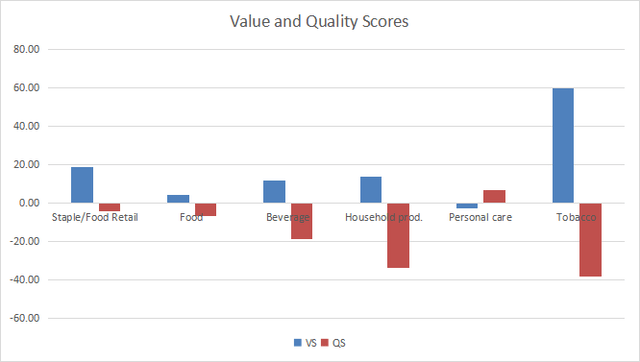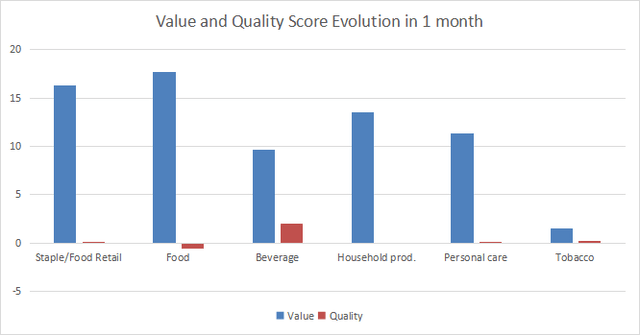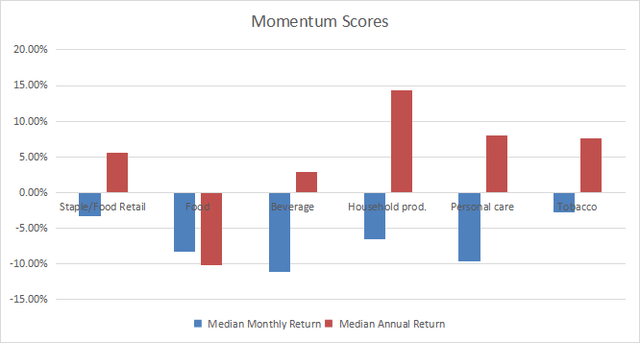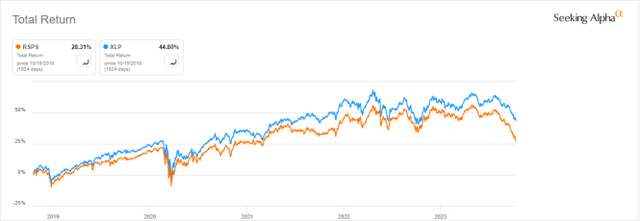Smile
This monthly article series shows a dashboard with aggregate industry metrics in consumer staples. It is also a review of sector ETFs like the Consumer Staples Select Sector SPDR ETF (XLP) and the Invesco S&P 500 Equal Weight Consumer Staples ETF (NYSEARCA:RSPS), whose holdings are used to calculate these metrics.
Shortcut
The next two paragraphs in italic describe the dashboard methodology. They are necessary for new readers to understand the metrics. If you are used to this series or if you are short of time, you can skip them and go to the charts.
Base Metrics
I calculate the median value of five fundamental ratios for each industry: Earnings Yield (“EY”), Sales Yield (“SY”), Free Cash Flow Yield (“FY”), Return on Equity (“ROE”), Gross Margin (“GM”). The reference universe includes large companies in the U.S. stock market. The five base metrics are calculated on trailing 12 months. For all of them, higher is better. EY, SY and FY are medians of the inverse of Price/Earnings, Price/Sales and Price/Free Cash Flow. They are better for statistical studies than price-to-something ratios, which are unusable or non available when the “something” is close to zero or negative (for example, companies with negative earnings). I also look at two momentum metrics for each group: the median monthly return (RetM) and the median annual return (RetY).
I prefer medians to averages because a median splits a set in a good half and a bad half. A capital-weighted average is skewed by extreme values and the largest companies. My metrics are designed for stock-picking rather than index investing.
Value and Quality Scores
I calculate historical baselines for all metrics. They are noted respectively EYh, SYh, FYh, ROEh, GMh, and they are calculated as the averages on a look-back period of 11 years. For example, the value of EYh for food in the table below is the 11-year average of the median Earnings Yield in food companies.
The Value Score (“VS”) is defined as the average difference in % between the three valuation ratios (EY, SY, FY) and their baselines (EYh, SYh, FYh). The same way, the Quality Score (“QS”) is the average difference between the two quality ratios (ROE, GM) and their baselines (ROEh, GMh).
The scores are in percentage points. VS may be interpreted as the percentage of undervaluation or overvaluation relative to the baseline (positive is good, negative is bad). This interpretation must be taken with caution: the baseline is an arbitrary reference, not a supposed fair value. The formula assumes that the three valuation metrics are of equal importance.
Current data
The next table shows the metrics and scores as of last week’s closing. Columns stand for all the data named and defined above.
VS | QS | EY | SY | FY | ROE | GM | EYh | SYh | FYh | ROEh | GMh | RetM | RetY | |
Staple/Food Retail | 19.09 | -4.03 | 0.0493 | 2.7539 | 0.0258 | 16.84 | 19.43 | 0.0397 | 1.8948 | 0.0294 | 16.42 | 21.74 | -3.28% | 5.50% |
Food | 4.15 | -6.65 | 0.0552 | 0.8554 | 0.0137 | 14.08 | 31.27 | 0.0451 | 0.6517 | 0.0233 | 15.28 | 33.09 | -8.38% | -10.21% |
Beverage | 11.97 | -18.45 | 0.0353 | 0.2785 | 0.0216 | 17.87 | 45.98 | 0.0347 | 0.2637 | 0.0168 | 23.62 | 52.59 | -11.22% | 2.82% |
Household prod. | 13.68 | -33.67 | 0.0287 | 1.3094 | 0.0463 | 5.94 | 39.96 | 0.0455 | 0.8746 | 0.0361 | 16.98 | 40.90 | -6.58% | 14.28% |
Personal care | -2.50 | 7.10 | 0.0388 | 0.4027 | 0.0180 | 20.88 | 62.62 | 0.0366 | 0.4319 | 0.0193 | 20.37 | 56.06 | -9.74% | 7.97% |
Tobacco | 59.89 | -38.33 | 0.0893 | 0.8658 | 0.0249 | 9.27 | 50.04 | 0.0597 | 0.4963 | 0.0160 | 34.05 | 52.06 | -2.76% | 7.53% |
Value And Quality chart
The next chart plots the Value and Quality Scores by industry (higher is better).
Value and quality in consumer staples (Chart: author; data: Portfolio123)
Evolution since last month
The value score has improved in all subsectors.
Value and quality variations (Chart: author; data: Portfolio123)
Momentum
The next chart plots momentum based on median returns by subsector.
Momentum in consumer staples (Chart: author; data: Portfolio123)
Interpretation
Tobacco is the most undervalued consumer staples industry relative to 11-year averages, but it also has the worst quality score. A note of caution: only five tobacco companies are in my reference universe. Therefore, statistics are less reliable than in other industries. Food/staples retail is quite attractive: it is undervalued by about 19% and has a quality score close to the historical baseline. Food and personal care are close to the baseline in both value and quality. Beverage and household products are moderately undervalued, but their quality scores are underwhelming.
Fast facts on RSPS
Invesco S&P 500 Equal Weight Consumer Staples ETF has been tracking the S&P 500 Equal Weight Consumer Staples Index since 11/01/2006. It has 39 holdings and a total expense ratio of 0.40%, which is significantly more expensive than the capital-weighted fund XLP (0.10%).
All positions have the same weight after every rebalancing, but they may drift with price action. The next table lists the current top 10 holdings, which have an aggregate weight of 28.3%. These are the constituents with the highest momentum since the last rebalancing. Risks related to individual companies are lower than in XLP, where the top 10 holdings weigh more than 65% of assets, and the top name, Procter & Gamble Co. (PG), is over 14%.
Ticker | Name | Weight% | EPS growth %TTM | P/E TTM | P/E fwd | Yield% |
WBA | Walgreens Boots Alliance, Inc. | 3.06 | -171.31 | N/A | 6.75 | 8.26 |
COST | Costco Wholesale Corp. | 2.98 | 7.74 | 40.04 | 36.34 | 0.72 |
PM | Philip Morris International, Inc. | 2.85 | -11.23 | 17.85 | 15.08 | 5.64 |
WMT | Walmart, Inc. | 2.83 | 3.67 | 30.78 | 24.69 | 1.43 |
CL | Colgate-Palmolive Co. | 2.81 | -22.20 | 39.56 | 22.45 | 2.71 |
MO | Altria Group, Inc. | 2.80 | 291.46 | 11.20 | 8.56 | 9.19 |
KHC | The Kraft Heinz Co. | 2.76 | 108.61 | 12.28 | 10.85 | 5.09 |
GIS | General Mills, Inc. | 2.76 | -13.79 | 15.39 | 14.05 | 3.74 |
CAG | Conagra Brands, Inc. | 2.74 | 88.78 | 12.25 | 10.30 | 5.08 |
PG | Procter & Gamble Co. | 2.74 | 1.65 | 24.53 | 22.63 | 2.60 |
RSPS is cheaper than XLP regarding the usual valuation ratios, as reported in the next table.
RSPS | XLP | |
Price / Earnings TTM | 21.89 | 23.3 |
Price / Book | 3.02 | 4.56 |
Price / Sales | 0.98 | 1.24 |
Price / Cash Flow | 14.6 | 15.39 |
Data: Fidelity
RSPS has outperformed the capital-weighted ETF since inception, but the difference in annualized return is only 31 bps. It is also a bit more volatile, which results in identical risk-adjusted performance (Sharpe ratio in the next table).
Total Return | Annual Return | Max Drawdown | Sharpe | StdDev | |
RSPS | 327.93% | 8.96% | -35.93% | 0.66 | 13.08% |
XLP | 307.65% | 8.65% | -32.39% | 0.66 | 12.48% |
Data and calculations: Portfolio123
However, RSPS has underperformed in the last 5 years (next chart).
RSPS vs XLP, last 5 years (Seeking Alpha)
In summary, RSPS is a solution for investors seeking exposure to consumer staples and willing to avoid concentration in the largest companies. It looks slightly superior to XLP in valuation and past performance. However, liquidity makes XLP a better instrument for tactical allocation and trading.
Dashboard List
I use the first table to calculate value and quality scores. It may also be used in a stock-picking process to check how companies stand among their peers. For example, the EY column tells us that a food company with an earnings yield above 0.0552 (or price/earnings below 18.12) is in the better half of the industry regarding this metric. A Dashboard List is sent every month to Quantitative Risk & Value subscribers with the most profitable companies standing in the better half among their peers regarding the three valuation metrics at the same time. The list below was sent to subscribers several weeks ago based on data available at this time.
USNA | USANA Health Sciences, Inc. |
MED | Medifast, Inc. |
COKE | Coca-Cola Consolidated, Inc. |
EPC | Edgewell Personal Care Co. |
POST | Post Holdings, Inc. |
CALM | Cal-Maine Foods, Inc. |
COTY | Coty, Inc. |
It is a rotational model showing long-term excess return, not the result of an analysis of each stock.
















